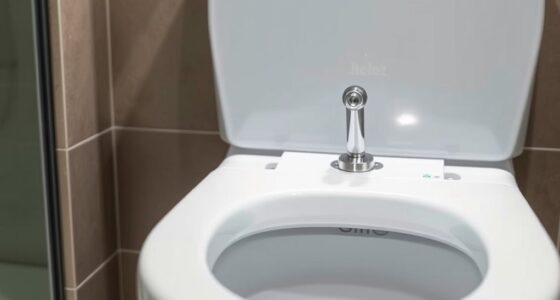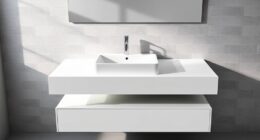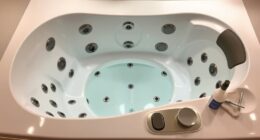We’ve all experienced it: standing in front of a blocked bathroom sink, annoyed and looking for a solution.
But fear not, because we’re here to guide you through the steps of unclogging that stubborn hair-filled drain.
With a few simple tools and our step-by-step instructions, you’ll have your sink flowing smoothly again in no time.
So roll up your sleeves and let’s get to work, mastering the art of unclogging a bathroom sink clogged with hair.

Key Takeaways
- Install a drain strainer to prevent hair from entering the pipes.
- Have a plunger ready to dislodge the hair clog.
- Consider using a mixture of baking soda and vinegar to dissolve the hair.
- Use a hair removal tool to catch and remove the hair clog.
Gather the Necessary Tools
To begin, we’ll gather the necessary tools for unclogging a bathroom sink clogged with hair. Before diving into the process, it’s crucial to take preventive measures to minimize the chances of clogs in the future. Installing a drain strainer can trap hair and prevent it from entering the pipes.
Now, let’s move on to the tools needed for the unclogging process. You’ll need a pair of rubber gloves to protect your hands from any debris. Additionally, a plunger and a drain snake will come in handy to dislodge the hair clog. Alternatively, you can use a mixture of baking soda and vinegar to dissolve the hair.
Having these tools ready will ensure a smooth and efficient unclogging process.
Remove the Sink Stopper
After gathering the necessary tools, we can now proceed to remove the sink stopper.

Here is a step-by-step guide to help you successfully remove the sink stopper:
- Step 1: Locate the sink stopper underneath the sink. It’s usually connected to a rod or lever.
- Step 2: Unscrew the nut or clip that holds the rod or lever in place. Use pliers or a wrench if necessary.
- Step 3: Disconnect the rod or lever from the stopper by pulling it out or twisting it counterclockwise.
- Step 4: Lift the sink stopper out of the drain. Be careful not to drop it or damage the surrounding areas.
- Step 5: Clean the sink stopper thoroughly and inspect it for any damage. If necessary, replace the sink stopper with a new one.
If the hair clog persists, consider using alternative hair removal methods or seeking professional help.
Try Using a Plunger
We can attempt to unclog the bathroom sink clogged with hair by using a plunger. Plungers are effective tools for dislodging hair clogs in sinks. Follow these steps to use a plunger properly:
- Fill the sink with enough water to cover the plunger cup.
- Position the plunger over the drain, ensuring a tight seal.
- Push the plunger down firmly and then pull up quickly, creating suction.
- Repeat the plunging motion several times to help break up the clog.
- After a few attempts, check if the water starts to drain. If it does, continue plunging until the clog is completely cleared.
If the plunger method doesn’t work, there are alternative unclogging methods you can try, such as using a drain snake or a mixture of baking soda and vinegar.

To prevent hair clogs in bathroom sinks, consider using a hair catcher or regularly cleaning the drain.
Use a Hair Removal Tool
Using a hair removal tool is another effective method for unclogging a bathroom sink clogged with hair. Here are some steps to follow when using a hair removal tool:
- Start by removing the sink stopper or drain cover to access the clog.
- Insert the hair removal tool into the drain and push it down until you feel resistance.
- Rotate the tool clockwise and counterclockwise to catch and remove the hair clog.
- Pull the tool out slowly, making sure to collect any hair that comes out with it.
- Repeat the process if necessary until the clog is completely cleared.
Remember, using a hair removal tool is just one of the alternative methods you can try.
To prevent future clogs, consider taking preventive measures such as using a drain cover or regularly cleaning the drain to remove any hair buildup.

Flush the Drain With Hot Water
Continuing the process of unclogging a bathroom sink clogged with hair, we can now move on to flushing the drain with hot water. This step is essential for clearing any remaining debris and ensuring proper water flow.
Using hot water to unclog drains offers several benefits. Firstly, hot water helps to dissolve and break down greasy substances that may be contributing to the clog. Additionally, the heat can help to soften and loosen hair strands, making them easier to flush away.
However, it’s crucial to avoid some common mistakes when using hot water to unclog a sink. Firstly, ensure that the water isn’t boiling, as it can cause damage to the pipes. Secondly, avoid using hot water if you have PVC pipes, as they can become warped or damaged. Finally, be cautious not to splash hot water on yourself while performing this step.
Frequently Asked Questions
How Long Does It Typically Take to Unclog a Bathroom Sink Clogged With Hair Using a Plunger?
Typically, it takes a few minutes to unclog a bathroom sink clogged with hair using a plunger. To prevent hair clogs, use a drain cover. Alternative methods include using a drain snake or chemical drain cleaners.

Can I Use Any Type of Plunger, or Is There a Specific One Recommended for Unclogging Bathroom Sinks?
There are different types of plungers available for unclogging bathroom sinks. It’s important to choose the right one for maximum effectiveness. To prevent hair clogs, use a drain stopper or catch hair with a mesh screen.
Is It Safe to Use Chemical Drain Cleaners to Unclog a Bathroom Sink, or Are There Any Potential Risks?
Using chemical drain cleaners to unclog a bathroom sink has pros and cons. They can be effective but may damage pipes and harm the environment. Alternatives include using a plunger, a drain snake, or a homemade mixture of baking soda and vinegar.
How Often Should I Clean My Bathroom Sink to Prevent Hair Clogs?
To prevent hair clogs in bathroom sinks, we recommend cleaning the drains regularly. Effective cleaning involves removing the sink stopper, using a drain snake or wire hanger to remove hair, and flushing the drain with hot water and vinegar.
What Should I Do if None of the Methods Mentioned in the Article Work to Unclog My Bathroom Sink?
If none of the methods mentioned in the article work to unclog our bathroom sink, we can try alternative methods like using a plunger or a drain snake. If all else fails, we should consider seeking professional help.

Conclusion
So there you have it, folks! Congrats on successfully unclogging your bathroom sink filled with hair. It’s like a mini-adventure in the world of plumbing!
Remember, next time you find yourself knee-deep in hair clogs, don’t panic. Just grab your trusty tools, plunge away, and flush it all down with scorching hot water.
Who knew battling hair could be so exhilarating? Happy unclogging!










